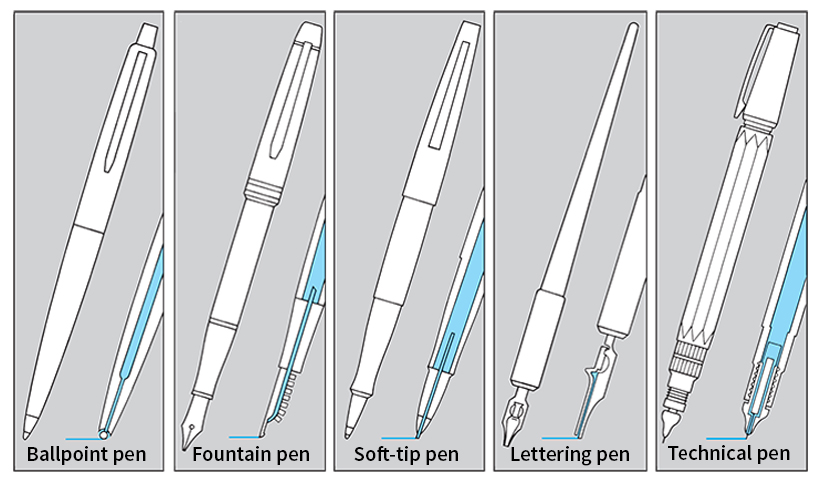Pen is an instrument used for writing or drawing with ink. Pens of one type or another have been used for thousands of years. Today, pens rank among the most widely used writing instruments. The world’s pen manufacturers produce billions of pens annually.
There are five main kinds of pens. They are (1) ballpoint pens, (2) fountain pens, (3) soft-tip pens, (4) roller ball pens, and (5) specialty pens.

Ballpoint pens
have a tiny ball made of brass, steel, or tungsten carbide as their writing tip. A compartment called the ink reservoir holds the ink, and a narrow tube links the reservoir to the ball. The ball, which is fitted into a socket, turns as it rolls across the paper, carrying ink from inside the pen onto the paper. Many ballpoint pens have a plastic cap that helps prevent ink from drying out on the ball. On others, a push-button mechanism draws the pen point into the body of the pen.
Most ballpoint pens depend on gravity to pull the ink to the ball. For this reason, ballpoint pens generally do not write well when held sideways. However, some ballpoints are designed so that slight pressure is always applied behind the ink column. This design enables the ink to move constantly forward and the pen to write even when its point is higher than its back end.
Ballpoint pens use a thick, sticky ink because a thinner ink would leak out around the ball. But the use of such ink makes ballpoint pens write less smoothly than most other pens.
Fountain pens
have a somewhat triangular writing point, called a nib, which is made of gold or stainless steel. A system of narrow tubes known as the feed carries the ink from the pen’s reservoir to the nib.
Fountain pens use a highly fluid ink. They rely on a property called capillary action to draw the ink into and through the feed. Capillary action causes the inner surface of the tubes to attract molecules of ink. These ink molecules, in turn, attract other ink molecules, and the feed fills with ink from the pen’s reservoir. See Capillary action .
The feed in a fountain pen also includes a number of air passages that lead to the reservoir. These passages allow air to fill the top of the reservoir as ink is drawn from the bottom. Thus the air pressure inside the pen remains equal to the air pressure outside the pen, and the ink flows easily. If the air pressure inside the ink reservoir is lower than the atmospheric pressure outside, the ink will not reach the point and the pen will fail to write. However, if the air pressure over the ink column becomes greater than the air pressure outside the pen, ink will flood out from the front of the pen. To avoid such flooding, fountain pens are designed with a collector. The collector, which is located near the nib, consists of a series of fins and spaces that provide enough additional room to accommodate forward moving ink.
Soft-tip pens,
also called porous-point pens, have a relatively soft writing tip. Some soft-tip pens, called felt-tip pens, have a feltlike writing tip. The tip of others is made of absorbent plastic.
Soft-tip pens use fluid, brightly colored inks. The reservoir in a soft-tip pen consists of a synthetic material made up of many fibers. This capillary reservoir holds ink much as a sponge holds water. During writing, the absorbent tip of the pen draws ink from the reservoir onto the paper.
Roller ball pens
combine certain features of ballpoint, fountain, and soft-tip pens. Like ballpoint pens, roller ball pens have a tiny ball that turns in a socket at their tip. But unlike ballpoints, roller ball pens use highly fluid inks, which allow them to write as smoothly as soft-tip and fountain pens.
Roller ball pens may have either a capillary reservoir similar to that used in soft-tip pens or a reservoir like that of ballpoints. A wick made of an absorbent material draws ink from the reservoir and carries it to the ball. The wick can carry only a limited amount of ink at any one time. In this way, the wick regulates the flow of ink and prevents it from leaking out.
Specialty pens
are designed for specific purposes. For example, artists and mechanical drafters use a pen called a technical pen. This pen comes with a set of interchangeable pen points of varying widths. Another special pen, called a lettering pen, is used to create an elegant style of handwriting called calligraphy.
History.
As early as 4000 B.C., ancient peoples used crude pens consisting of hollow straws or reeds that supported a short column of liquid. During the 500’s B.C., people began to make pens from the wing feathers of such birds as geese and swans. The shaft of the feathers was hardened, and the writing tip was shaped and slit to make writing easy. These feather pens were known as quill pens, and they were widely used until the development of steel-nib pens in the 1800’s.
By the late 1800’s, inventors had perfected an early type of fountain pen. This pen represented a major advance because it had an ink reservoir and a capillary feed. Earlier pens held only a small amount of ink at a time and had to be repeatedly dipped in ink.
John H. Loud, an American inventor, patented a ballpoint pen in 1888. However, ballpoint pens received little notice until World War II (1939-1945). Many pilots began using ballpoint pens during this conflict, because such pens did not leak at high altitudes. After the war, ballpoint pens became increasingly popular. Soft-tip pens and roller ball pens both were introduced during the 1960’s.
